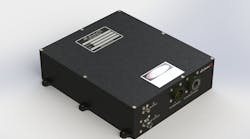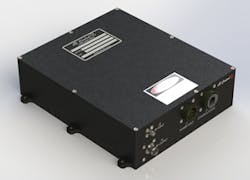This file type includes high-resolution graphics and schematics when applicable.
Vacuum tubes can yield impressive amounts of microwave power in small packages, but they must be properly cooled for long-lifetime operation. On that front, the model dB-4150 microwave power module (MPM) developed by dB Control combines a first-stage solid-state amplifier and second-stage traveling-wave-tube (TWT) power booster with effective conductive cooling.
This novel configuration (see figure) delivers 100-W output power from 6 to 18 GHz in both pulsed and continuous-wave (CW) operating modes. It is engineered and constructed for the challenging environmental conditions found in military applications, including under extreme shock and vibration, high humidity, and wide temperature ranges.
The dB-4150 MPM is a compact but robust wideband amplifier well-suited for wideband military applications in electronic-countermeasures (ECM) systems and electronic-warfare (EW) simulators. It is at home boosting either CW signals or signals with high pulse-repetition-frequency (PRF) pulse modulation. It can handle pulse widths as narrow as 1 µs through CW signals at maximum PRFs to 10 kHz.
The MPM achieves 50-dB gain at its rated 100-W output-power level with spurious levels controlled to –50 dBc. Harmonics at the most “susceptible” frequency, 6 GHz, are –4 dBc (with harmonics above 9 GHz outside the operating frequency range of the MPM). Exhibiting input VSWR of 2.0:1 at 50 â¦, the MPM is specified for maximum load VSWR of 1.50:1 for full compliance with its performance specifications.
Small with Smarts
This rugged little MPM measures just 12.876 × 9.4 × 2.563 in., but it is densely packed, weighing 9.5 lbs. It comes with female SMA input connectors and female TNC output connectors. The primary supply voltage is +270 V dc, with an option for +28 V dc. It operates with differential or transistor-transistor-logic (TTL) modulation control and includes an Ethernet interface (and is available with a serial interface as an option). As a “smart” MPM, it features monitors for forward and reverse power, along with status indicators for power and equipment faults.
For those concerned with reliability, especially for such a small unit that generates such high output-power levels, the MPM is generously equipped with protection. It incorporates protection mechanisms to guard against overly high reflected power levels and exceeding the current limits for the TWT helix, the voltage limits for the TWT cathode, and the operating-temperature limits of the TWT and the MPM.
The dB-4150 MPM is designed to handle extremely hostile operating conditions, including high vibration levels and shock to 15 g. It can fucntion in environments with as much as 95% relative humidity (RH) and at altitudes to 50,000 ft. for avionics applications. Operating temperature ranges from –40 to +85°C. As an option, the MPM can be supplied for use from 5 to 18 GHz for extremely broadband applications.
dB Control, 1120 Auburn St., Fremont, CA 94538; (510) 656-2325, FAX: (510) 656-3214.


